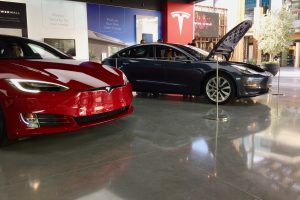- 🚗 Tesla’s newer vehicles in Norway lack a traditional turn signal stalk, causing issues in driving schools.
- ⚙️ The turn signal design features force touch buttons on Model S, Model X, and the “Highland” Model 3, aligning with Tesla’s minimalist approach.
- 🌐 Tesla’s move towards self-driving involves phasing out traditional elements like a larger steering wheel and eliminating turn signal stalks.
- 🚦 Norwegian driving school, Harstad Traffic School, faced difficulties with the turn signal buttons, particularly when exiting roundabouts.
- 📉 Instructors and students experienced challenges activating the turn signals, leading to concerns about potential incidents and a ban on Teslas in some schools.
As the automotive world hurtles towards an era of innovation and autonomous driving, Tesla, a trailblazer in the electric vehicle (EV) realm, finds itself at the forefront of a unique challenge. The absence of a traditional turn signal stalk in Tesla’s newer vehicles is causing a stir, particularly in Norwegian driving schools. Let’s delve into the intricacies of this issue, exploring the design, its implications, and the reactions it has stirred in the education sector.
The Minimalist Turn Signal Design 🚗⚙️
Tesla’s commitment to minimalism and cutting-edge design is well-known, and this extends to the user interface inside its vehicles. In the case of turn signals, the traditional stalk is replaced by force touch buttons on models like the Model S, Model X, and the “Highland” variant of the Model 3. This design shift aligns with Tesla’s overarching philosophy of simplifying the driving experience.
Towards Self-Driving: Phasing Out Tradition 🌐
Tesla’s vision for the future of driving is intricately tied to self-driving capabilities. In pursuit of this ambitious goal, the company has gradually eliminated traditional elements from its cabin. The journey began with a smaller steering wheel, or Yoke, and has extended to the removal of turn signal stalks. For Tesla, each design alteration is a step closer to fully autonomous driving.
Turmoil at Harstad Traffic School 🚦📉
However, the sleek and modern design is not without its challenges, especially in the real-world setting of driving schools. Harstad Traffic School in Norway, run by Jåhn Hansen Øyen, found itself grappling with the nuances of Tesla’s turn signal buttons, particularly during maneuvers like exiting roundabouts.
In a candid assessment, Øyen noted, “I tested the Model 3 and noticed that I lost both focus and direction in roundabouts.” This sentiment echoed among other instructors who, when driving the vehicle, felt an increased risk of potential incidents due to the button’s design.
Challenges Faced by Instructors and Students 🚦📉
The issues primarily revolved around the accessibility and activation of the turn signal buttons. Instructors and students alike faced difficulties in smoothly using the buttons, leading to concerns about safety and the potential for accidents. This raised a red flag in the eyes of the driving school, resulting in the decision to ban Teslas from several institutions.
Navigating the Future: Balancing Innovation and Safety 🚗🚦
As we explore this intersection of innovation and safety, it’s essential to recognize the ongoing evolution of automotive technology. Tesla’s approach, while pushing boundaries, should prompt a broader conversation within the industry and among consumers.
In Conclusion: A Turning Point for Tesla? 🔄
Tesla’s turn signal challenge in Norwegian driving schools serves as a microcosm of the larger discourse surrounding the transformation of driving experiences. As we navigate this turning point, it prompts reflection on how innovation can coexist seamlessly with safety, ensuring a future where technological advancements enhance, rather than compromise, the driving experience.





